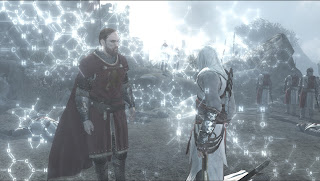The series started off with an expansive yet minimalist presentation style. Cutscenes were done such that the player always retained control of Altair with their semi-interactive style, with the only real non-interactive sequences being the panoramic camera sweeps upon approaching a city for the first time, or synchronising from a viewpoint. Even when control was removed from the player, the cinematics conveyed a sense of scale and completeness of the environment. AC1 was presented as a giant and finely crafted sandbox for the player to explore with as few constraints as possible, and the presentation and gameplay supported this.
The problem with an enormous sandbox is that it can potentially result in a limited about of designed gameplay, an inherent problem of the original game. Thus AC2 came in with its expanded story, but consequently a more prescriptive presentation style. The quicktime events of the cutscenes disappeared, which while perhaps making the player feel less involved, it ensured that the presentation of the cinematic sequences were crafted for maximum effect, with every shot delivering nuance of story and character. While this does lose some freedom for the player, the increased impact of the narrative is arguably worth it.
Not having to worry about "glitches" was ultimately a blessing for cutscenes
The quicktime button events of AC2 were far worse, but these (fortunately) happened infrequently enough that the player didn't really have to worry about them, they didn't make much difference to the cutscene sequences, and they were mercifully dropped after this game.
A changing presentation resulted in a tighter experience from a narrative and gameplay perspective, and focused the player on specific areas and zones. Vast areas that were explored a single time (if at all) were ditched in favour of smaller environments that the player could become familiar with. This helped provide additional impact for the more personal story of Ezio, as it helped the player associate with the concept that he was fighting for people and places that he cared about. While this was perhaps slightly undone by the near identical assassin recruits you trained and promoted, it still increased the player's level of engagement with the setting.
There was an overall improvement in the graphical quality of the series as well. While the long draw distance to see vast panoramas has remained fairly constant, the diversity and complexity of the environments has provided some really stunning scenes for the player to view. The fact that the series deals with some pretty amazing architecture definitely doesn't hurt at all, but the art team still manage to pull the detail off with definite skill.
The improvement in the character models and facial appearance is also noteworthy, which was fairly essential given the increased focus on a more cinematic presentation, leading to more close up shots of character's faces that requires that higher level of fidelity. The ability to choose a desired colour scheme for Ezio's outfit was just another small bit of icing on the cake that added a little more character.
So many different colours, yet somehow no outfit looks inconspicuous...
In the first four games, Assassin's Creed moved from wide empty areas to tightly crafted cities. While the impressive nature of the level design of the original game cannot be denied, a narrower focus has probably allowed more players to better appreciate the level of detail and effort that has gone into creating the environments for each game. The presentation of the series has improved along the way even if the scope diminished, and it could be argued that the games became better as a result.







No comments:
Post a Comment